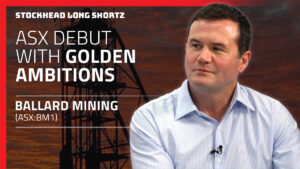I hate to bother you, King ASX, but there’s an unruly crowd-source mob attacking the castle gates

What do we want? Somewhere to invest $15!! When do want it? It's been around for 5 years already!! Pic via Getty Images.
There’s not been a lot of IPO action on the ASX these past 12 months, but the list of crowd-sourced funding (CSF) successes is very much on the rise.
FY23 was a bit of a grind in many respects for the ASX, coming off the back of an even more difficult FY22 which left a large number of people somewhat sheepish and gun shy about making any investments down the risky end of the profit pool.
It was a tough environment for even the hardiest of rusted-on companies, which made listing on the ASX too much of a mountain to climb, leaving just 57 companies to run through the IPO mill and go public in the 12 months to June 2023.
Which isn’t great news, obviously, but it serves as a very handy yardstick for those in the parallel money-raising, company boosting business of crowd-sourced fundraising (CSF), which is exactly what it sounds like.
Someone has a company with a great idea and wants to grow it, but listing on the ASX is (I assume, because I’ve never personally done it) like the aftermath of a terrible back-alley curry in the down’n’out parts of any major city: Lots of blood, sweat and tears, plus a mountain of paperwork to contend with.
CSF scores its first win over the ASX IPO field
Last financial year saw a major milestone in the growing CSF marketplace, with that sector banking its first-ever ‘win’ in terms of sheer numbers against the ASX.
The local bourse saw those 57 IPOs I mentioned earlier, while the established CSF sector notched up 85 successful offers completed, according to Matt Vitale, CEO of Birchal, an Australian Equity Crowdfunding platform for consumer brands and companies.
Birchal’s been plugging away in the CSF space since 2018, when it officially became A Thing in Australia. Since then, Vitale says, official CSF funding efforts have seen $248 million raised across around 327 successful CSF offers – 28 of which landed the companies who took this route more than $2 million apiece.
Granted, that’s a drop in the bucket compared to the kinds of IPOs we’ve seen on the ASX in that time – heck, even one of the most recent ones, Redox (ASX:RDX) eclipses all of that on its own, after its $402 million at $2.55 IPO saw it hit the market last week, only to get knee-capped on a shocker of a day.
But in that lone fact, the key difference between companies choosing to take the CSF highway rather than the IPO autobahn becomes clear.
CSF is for the little guys. And there are lots of little guys.
Nawww.
A Brief History of Time. And CSF, if you’re lucky
CSF isn’t exactly “new” – it’s been around in various forms across the globe for a while, and the way it works is right there in the name – it’s crowd-sourced funding, like the way already-wealthy TV stars like that big-nose fella from Scrubs put his hand out so he could risk US$2.6 million of his fans’ hard-earned to make a film called I Wish I Was Here.
If you haven’t seen it, don’t. It’s just… awful.
But the point is that Braf reckons it couldn’t have been made without the $2.6 mill from fans – and a top-up from an existing studio to get it the budget to $10 million.
And we’ve all seen the countless Shocking Surprise Success stories, where some yo-yo with a perfectly terrible business idea catches the internet on an off day, and wakes up to discover he now has a cool $15 million to indulge his passion of making documentaries about how animals are confused by the existence of pipe cleaners.
Anyway – CSF works like that, except the rules are heaps tighter, which lessens the chance of a dirty, old-skool rug pull by some of the more nefarious Small Bzns types who prey on well-meaning community-minded investors. Plus, the government’s involved, so you can call the cops and have people pepper-sprayed if it all goes belly-up. Possibly.
But in dollar value terms, the CSF space slots in beneath the ASX and its fancy-shmancy IPOs, giving small entrepreneurs access to investment money beyond what they’d be likely to be able to raise on their own, through access to the pool of investors who are up for sticking $1,000 bucks into something, to help get it off the ground and – hopefully – see a return down the track.
So that $248 million in CSF funding in Australia breaks down into these smaller chunks: the money went to 327 successful companies, with the average deal size resting at a cool $763,000.
The average investment from the CSF investors is tiny compared to an IPO – we’re talking $1,739 – but it’s been enough to build a swathe of small businesses into a genuine presence in the Aussie SME field, boasting a total market cap of $4.17 billion.
Interestingly, CSF also offers a roadmap for teensy-tiny companies to build their way up to a crack at the ASX Big League. One company, Biome Australia (ASX:BIO) has already made the leap, and Birchal says that two more are on the way.
Line Hydrogen plans to list locally in September this year, while a company called ALTA is looking overseas for somewhere to list as well.
Is it time to break out the life support for IPOs?
Th short answer is “no” – but that “no” does have a caveat, because ASX IPOs are trending low – like, real low – at the moment, and some of the important numbers have been in decline for a few years.
For example, looking at the data from 2020 through to 2023, you’ll notice that a really important data point – first day returns for companies listing through IPOs, which historically have been red-letter, pop the champagne, ‘dear sweet merciful Mammon, we’re rich!’ kinda days – has gone a bit… soggy.
The numbers from recent years paint a painful picture of first-day average gains moving from a very healthy 32.0% in 2020, falling to 19.3% in 2021, dropping again to 16.3% in 2022 and then soiling the company Sleepmaker to hit -0.05% in 2023.
The declining returns for companies listing, when held up alongside the dwindling number of companies even bothering to try, show a bleak moonscape, but if you want more factoids to ruin your day, here’s a big bunch of craters to go with it.
At the end of 2022, only 29% of the 89 companies that listed onto the ASX were still ahead of where they’d started – the rest, thanks to the marvels of modern mathematics – had shrunk.
In some cases, quite badly, leaving the median return across those 89 companies at a bed-sweat-inducing -22.50%.
Compare that to the opening months of 2023, when – between January 1 and May – there were 10 IPOs on the ASX… nine of which are in the Resources game, with the outlier being AI tech mob Acusensus (ASX:ACE).
Of those, three companies are still doing well. Evergreen Lithium, (ASX:EG1) is up 36%, lithium player Leeuwin Metals (ASX:LM1) is up 72% and lithium hunter Dynamic Metals (ASX:DYM) is 50% higher, as of market close on 11 July, 2023. See if you can spot the pattern there.
The rest of them are down, from the relatively mild 5.0% drop for High-Tech Metals (ASX:HTM) to soul-destroying lows like ACDC Metals’ (ASX:ACD) 57% slump, and Gold Hydrogen (ASX:GHY), which has plummeted 48%.
The only non-resources lister from that period, Acusensus, is down just over 15%, in case you were wondering.
And, for the sake of being thorough for a change, Biome – the CSF starter that jumped ship to the ASX – IPO’d with $8 million at $0.20 per share, and is down around 50% since then, currently changing hands for $0.105 a pop.
So unless you’ve got several kajillion tonnes of lithium in your back pocket, those numbers suggest that you’d need your head examined for thinking that listing in the current environment makes even a skerrick of sense.
Which in turn is probably why alternate routes for funding, like CSF, are starting to grab more serious chunks of attention from small business owners, and small bank balance investors, than ever before.
Related Topics
UNLOCK INSIGHTS
Discover the untold stories of emerging ASX stocks.
Daily news and expert analysis, it's free to subscribe.
By proceeding, you confirm you understand that we handle personal information in accordance with our Privacy Policy.








